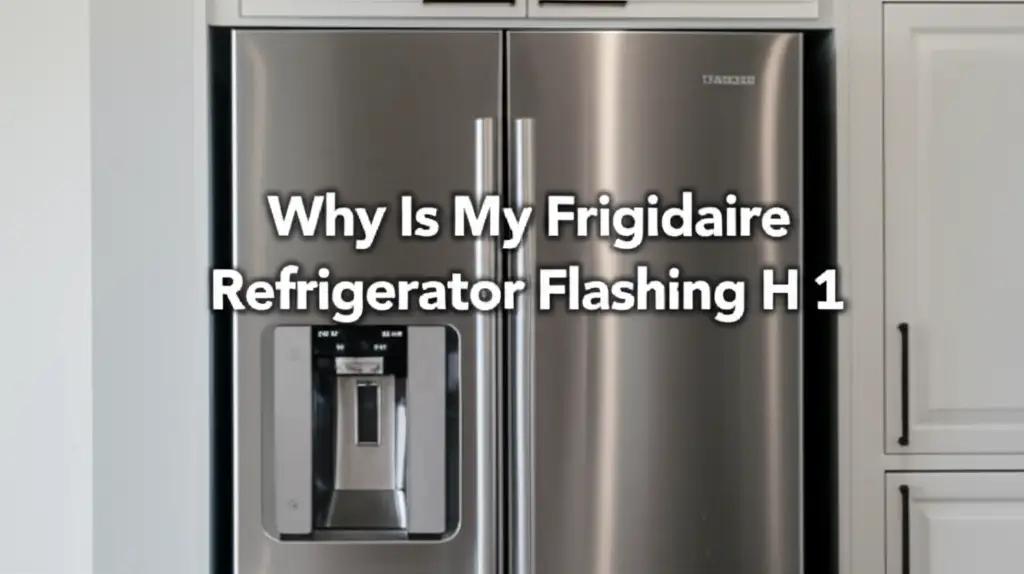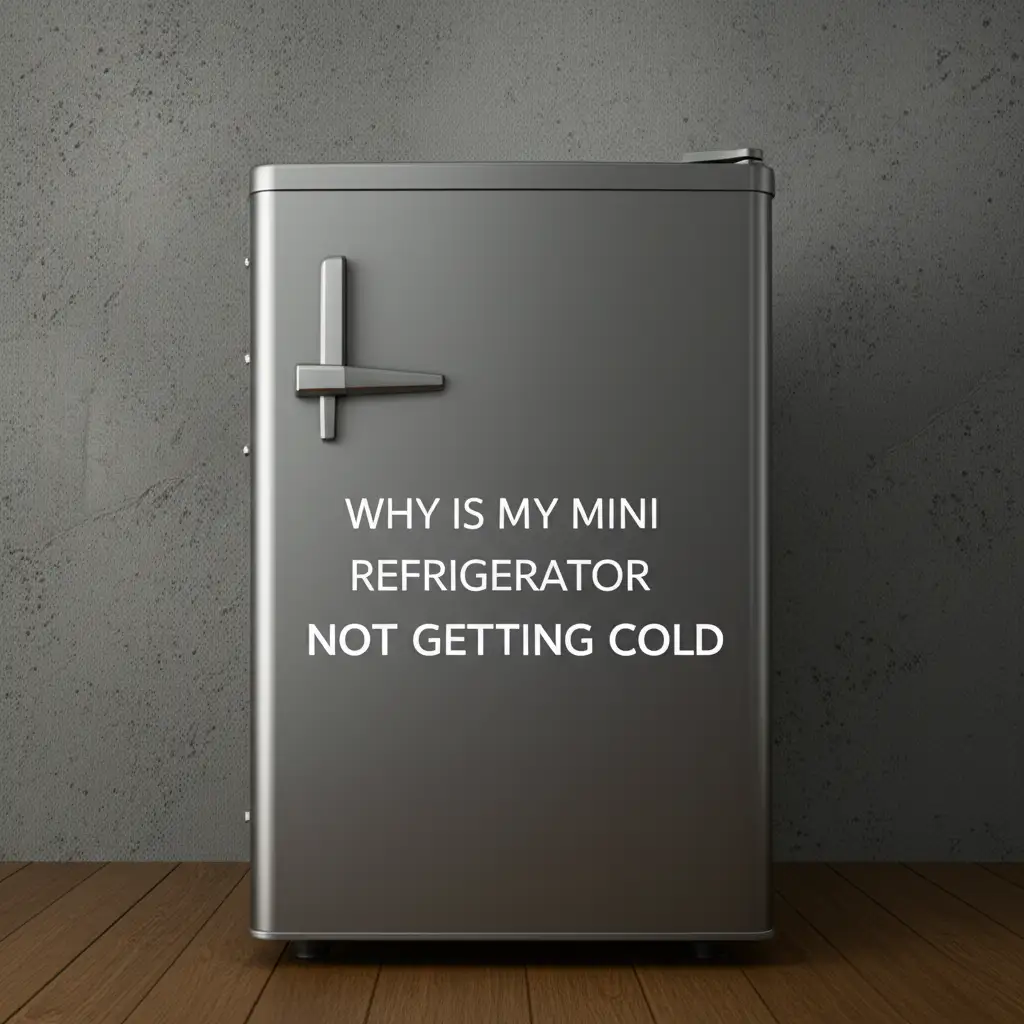· Katria Melrose · Home Appliances · 19 min read
Why Is My Frigidaire Refrigerator Flashing H 1

Frigidaire Refrigerator Flashing H 1: What It Means and How to Fix It
There are few things as alarming as seeing your refrigerator display an error code. If your Frigidaire refrigerator is flashing H 1, you are likely feeling worried about your food and the appliance itself. This common error code can cause confusion, but understanding its meaning is the first step toward a solution. We understand how frustrating it is when your essential home appliances show signs of trouble.
This comprehensive guide helps you understand the H 1 error. We explore the specific components that trigger this code. You will learn practical, step-by-step troubleshooting methods. We cover everything from simple resets to checking key parts like the thermistor and control board. Our goal is to empower you with the knowledge to diagnose and fix the issue. Let’s make sure your Frigidaire refrigerator operates correctly again.
Takeaway
If your Frigidaire refrigerator flashes H 1, act quickly.
- The H 1 error usually points to an issue with the fresh food thermistor or temperature sensor.
- Perform a simple power reset first to clear temporary glitches.
- Check the fresh food compartment temperature settings and actual temperature.
- Inspect the thermistor for physical damage or loose connections.
- Consider replacing the fresh food thermistor if it fails resistance tests.
- A faulty main control board is a less common but possible cause.
- Always disconnect power before performing any repairs.
What does H 1 mean on a Frigidaire Refrigerator?
If your Frigidaire refrigerator is flashing H 1, it typically indicates a problem with the fresh food compartment’s temperature sensor, also known as the thermistor. This sensor sends temperature readings to the main control board. The H 1 code appears when the control board detects an incorrect or open circuit reading from this sensor, suggesting a potential issue with temperature regulation.
Understanding the H 1 Error Code on Your Frigidaire Refrigerator
Discovering an H 1 error code on your Frigidaire refrigerator can be unsettling. This specific code does not mean complete appliance failure. Instead, it serves as a diagnostic message. The H 1 error alerts you to a problem within the fresh food section’s temperature monitoring system. It tells you the thermistor, or temperature sensor, in the fresh food compartment is not providing valid data to the refrigerator’s main control board.
When your Frigidaire refrigerator flashes H 1, it generally means the fresh food thermistor circuit is open. This situation prevents the control board from accurately monitoring the internal temperature. The refrigerator cannot tell if the fresh food compartment is too warm or too cold. This can lead to improper cooling or even freezing of your food items. Understanding this initial diagnosis is crucial for effective troubleshooting. Many common issues with refrigerators, such as beeping or not cooling, can also be related to sensor malfunctions or control board communication. For more information on related problems, you might find this article helpful: Why Is My Frigidaire Refrigerator Beeping And Not Cooling.
The thermistor is a crucial component in maintaining the ideal temperature inside your refrigerator. It is a resistor that changes its electrical resistance based on temperature. The control board interprets these resistance changes to regulate the cooling system. If the thermistor fails, or its connection becomes faulty, the control board receives an out-of-range signal. This signal then triggers the H 1 error code display. This error can sometimes coincide with other issues like ice buildup or unexpected water accumulation, which may lead to problems such as Why Does My Frigidaire Refrigerator Have Water In The Bottom.
Initial Troubleshooting Steps for the H 1 Error
When your Frigidaire refrigerator starts flashing H 1, the first thing you should do is perform some basic troubleshooting. These initial steps often resolve minor glitches. They can save you from unnecessary repairs or service calls. Before touching any internal components, always ensure the refrigerator is safe.
Power Cycling Your Refrigerator
A power reset is the simplest and most effective first step for many electronic issues. Just like a computer, your refrigerator’s control board can sometimes experience temporary software glitches. Unplugging the appliance for a few minutes can clear these errors. This action allows the system to reset its internal components and re-establish communication with all sensors.
To power cycle your Frigidaire refrigerator:
- Locate the power cord.
- Unplug the refrigerator from the wall outlet.
- Wait at least 5-10 minutes. This duration gives the control board enough time to fully discharge and reset.
- Plug the refrigerator back in.
- Check if the H 1 error code has cleared.
If the H 1 error disappears after the power cycle, it indicates a temporary glitch. If it reappears, the issue is more persistent. You will need to move on to further diagnostic steps. Sometimes, related error codes might appear, such as if your Frigidaire Refrigerator is Flashing H and Beeping.
Checking Temperature Settings and Door Seals
Incorrect temperature settings or compromised door seals can sometimes indirectly contribute to sensor readings. The control board might receive an “out-of-range” temperature if the refrigerator struggles to maintain its set point.
- Verify Temperature Settings: Ensure your fresh food compartment is set to the recommended temperature, typically around 37°F (3°C). Drastic temperature changes can sometimes confuse the sensor.
- Inspect Door Seals: Check the door gaskets for any tears, gaps, or signs of wear. A faulty seal allows warm air to enter the compartment. This warm air makes the refrigerator work harder and can affect sensor accuracy. Close the door on a piece of paper; if it slides out easily, the seal might be weak.
These simple checks help rule out common external factors. They also ensure the refrigerator can maintain its temperature efficiently. An efficiently running refrigerator is less likely to trigger sensor errors. This step is crucial before diving into more complex component inspections.
Diagnosing the Fresh Food Thermistor (Temperature Sensor)
The fresh food thermistor is the most common culprit when your Frigidaire refrigerator is flashing H 1. This small but vital component monitors the temperature inside the fresh food compartment. It sends critical data to the main control board. A fault here directly triggers the H 1 error.
Locating the Fresh Food Thermistor
The fresh food thermistor is typically located within the fresh food compartment itself. Its exact position can vary slightly depending on your specific Frigidaire model.
- Common locations:
- Behind the control panel on the ceiling of the refrigerator.
- Attached to the evaporator cover, often near the air return vent.
- Sometimes integrated into the light housing.
- Near the back wall of the fresh food section. You may need to remove shelves, drawers, or interior panels to access it. Always refer to your refrigerator’s user manual or a specific service diagram for precise location instructions. Before beginning any inspection, remember to unplug the refrigerator to prevent electric shock. Safety is paramount when working with electrical appliances.
Testing the Thermistor for Proper Function
Once you locate the thermistor, you can test its functionality using a multimeter. This test measures the thermistor’s electrical resistance. The resistance should change with temperature. A thermistor that shows infinite resistance (open circuit) or zero resistance (short circuit) is faulty.
Steps to test the thermistor:
- Disconnect Power: Unplug your Frigidaire refrigerator from the wall outlet. This step is non-negotiable for your safety.
- Access the Thermistor: Carefully remove any panels or covers to expose the thermistor.
- Disconnect Wires: Gently disconnect the wires leading to the thermistor. Make a note of which wire goes where, if necessary.
- Set Multimeter: Set your multimeter to measure ohms (Ω).
- Measure Resistance: Place the multimeter probes onto the two terminals of the thermistor.
- Check Readings: Compare the reading to a thermistor resistance chart for your specific Frigidaire model. These charts usually provide resistance values at different temperatures (e.g., 37°F / 3°C). A typical fresh food thermistor might read around 5,000 to 15,000 ohms at room temperature.
- Temperature Variation Test (Optional): You can place the thermistor in a glass of ice water (32°F/0°C) and then in warm water. The resistance should change accordingly. Resistance decreases as temperature increases for most thermistors.
If the multimeter reads infinite resistance (open circuit) or no resistance (short circuit) at room temperature, the thermistor is bad. It needs replacement. If the readings are way off the expected range, it also indicates a faulty part. This diagnostic step is critical for isolating the H 1 error. A malfunctioning thermistor often directly causes the H 1 code. This problem is similar to how a faulty sensor could cause issues like your Frigidaire refrigerator not cooling or freezing.
Addressing Wiring and Connection Issues
Even if your thermistor tests good, the H 1 error can still appear. This might happen due to problems with the wiring or connections leading to the thermistor or the control board. Electrical continuity is vital for proper sensor communication. Loose, damaged, or corroded wires can disrupt the signal.
Inspecting Wiring Harnesses and Connectors
A thorough visual inspection of all relevant wiring is a necessary step. Start from the thermistor itself and follow its wiring back toward the main control board. Look for any obvious signs of damage or wear.
- Frayed or Pinched Wires: Check if any wires are frayed, cut, or pinched by internal components. Rodent damage can also be a cause.
- Corrosion: Look for any signs of corrosion on the wire terminals or connectors. Corrosion can impede electrical flow.
- Loose Connections: Ensure all connectors are firmly seated. Vibrations from the refrigerator’s operation can sometimes loosen connections over time. Gently wiggle each connector to ensure it is snug.
Accessing these wires may require removing additional panels or components. Always remember to unplug the refrigerator before conducting any inspections or repairs. Safety is your top priority.
Checking for Continuity with a Multimeter
If visual inspection does not reveal any issues, you can use a multimeter to check for continuity along the wiring. This test ensures that electrical current can flow freely from one end of the wire to the other.
Steps to check wire continuity:
- Disconnect Power: Unplug the refrigerator.
- Isolate the Wires: Disconnect the wires leading from the thermistor to the main control board at both ends. You are testing the wires themselves, not the components.
- Set Multimeter: Set your multimeter to the continuity setting (often indicated by a speaker symbol or an ohm setting).
- Test Each Wire: Place one probe of the multimeter at one end of a wire and the other probe at the opposite end of the same wire.
- Listen for Beep: A continuous beep or a reading of very low ohms (close to 0) indicates good continuity. If there is no beep or an infinite reading, the wire is broken or has a high resistance, meaning it needs replacement.
- Test for Shorts: Also, test each wire against the refrigerator chassis (ground) to ensure no shorts exist. There should be no continuity between the wire and the chassis.
If you find a break in continuity or a short, the specific wire or wiring harness needs replacement. Repairing damaged wiring can be complex. You might need to splice in new wire or replace the entire harness. Secure, intact wiring is essential for the thermistor to send accurate temperature signals to the control board. Issues like a faulty defrost system can also lead to sensor errors due to ice buildup, which might require steps like putting the Frigidaire refrigerator into defrost mode.
Considering the Main Control Board
While the fresh food thermistor or its wiring are the primary suspects for an H 1 error, the main control board can also be the cause. The control board is the brain of your refrigerator. It receives signals from all sensors and controls all cooling functions. If it cannot properly read the thermistor’s signal, it will display the H 1 error.
How a Faulty Control Board Triggers H 1
A main control board can fail in several ways, leading to an H 1 error.
- Component Failure: Small electronic components on the board can burn out or become faulty. This prevents the board from correctly processing the thermistor’s input.
- Software Glitches: Although less common for persistent H 1 errors, software corruption on the board can cause incorrect interpretations of sensor data.
- Damaged Traces: Physical damage to the circuit board, such as cracked solder joints or damaged traces, can interrupt the thermistor’s circuit.
The control board interprets the thermistor’s resistance readings. If its internal circuitry for the thermistor input fails, it will register an “open circuit” condition, even if the thermistor itself is fine. This results in the H 1 error being displayed. This scenario is why ruling out the thermistor and wiring first is important.
Troubleshooting and Replacing the Control Board
Troubleshooting a control board is more complex than testing a thermistor. You cannot easily test individual components on the board without specialized equipment. The most common diagnostic approach is to replace it if all other potential causes are ruled out.
Steps if you suspect the control board:
- Rule Out Other Issues: Ensure you have thoroughly tested the fresh food thermistor and its wiring. These are far more common causes of the H 1 error.
- Visual Inspection: Before replacing, visually inspect the control board. Look for any signs of burning, bulging capacitors, or damaged circuits. These are clear indicators of board failure.
- Order Replacement: Purchase a new control board specifically for your Frigidaire refrigerator model. Ensure it is a compatible part.
- Disconnect Power: Always unplug the refrigerator before accessing the control board. The control board is typically located at the back of the refrigerator, behind a metal panel.
- Remove Old Board: Carefully disconnect all wire harnesses from the old board. Take pictures before disconnecting to ensure correct reassembly. Unmount the old board.
- Install New Board: Mount the new control board and reconnect all wire harnesses securely.
- Test: Plug the refrigerator back in and observe the display. If the H 1 error clears, the control board was the issue.
Replacing the main control board is a more advanced repair. If you are uncomfortable with this step, consider calling a qualified appliance technician. A professional can properly diagnose and replace the part safely. Problems with the main control board can also manifest as other issues, like your Frigidaire refrigerator water dispenser not working.
Preventing Future H 1 Errors and General Maintenance Tips
After you fix the H 1 error, taking steps to prevent its recurrence is wise. Regular maintenance helps prolong your Frigidaire refrigerator’s lifespan. It also ensures efficient operation. Most issues stem from wear and tear or minor environmental factors.
Regular Refrigerator Maintenance
Consistent maintenance can significantly reduce the chances of encountering error codes.
- Clean Coils: Dust and debris on the condenser coils force the refrigerator to work harder. This can strain components, including sensors and the control board. Clean them every 6-12 months. You can find the coils at the bottom or back of the refrigerator. You can learn more about general maintenance in articles like How To Clean Under A Refrigerator.
- Check Door Gaskets: Regularly inspect door seals for cracks, tears, or looseness. Damaged gaskets allow warm air in, which can affect temperature stability and sensor readings. Clean them with mild soap and water to keep them pliable.
- Monitor Temperature: Use an external thermometer to periodically check the actual temperature in your fresh food compartment. This helps verify that the internal sensor and cooling system are functioning correctly. Aim for 37°F (3°C) in the fresh food section.
- Keep Vents Clear: Ensure that no food items or containers block the internal air vents. Proper airflow is essential for even cooling and accurate temperature sensing. Blocked vents can lead to temperature inconsistencies.
Understanding Environmental Factors
The environment around your refrigerator can also impact its performance and potentially contribute to sensor errors.
- Proper Ventilation: Ensure adequate space around the refrigerator for air circulation. If the appliance is crammed into a small space, it can overheat. This overheating stresses electronic components like the control board and sensors.
- Room Temperature: Avoid placing the refrigerator in extremely hot or cold environments. Garages or basements with wide temperature swings can challenge the refrigerator’s ability to maintain stable internal temperatures, potentially leading to sensor issues.
- Power Stability: Use a surge protector for your refrigerator if your home experiences frequent power fluctuations or outages. Power surges can damage sensitive electronic components within the control board or sensors.
By integrating these maintenance practices and considering environmental factors, you create optimal conditions for your Frigidaire refrigerator. This proactive approach minimizes stress on its components, including the temperature sensor. This helps prevent the reappearance of the H 1 error.
When to Call a Professional Appliance Technician
While many H 1 error issues on Frigidaire refrigerators are DIY-friendly, some situations warrant professional help. Knowing when to call a technician can save you time, frustration, and potentially further damage to your appliance.
Situations Requiring Expert Intervention
Consider calling a qualified appliance technician if:
- You’ve Exhausted All Troubleshooting: You have performed all the recommended troubleshooting steps. This includes power cycling, testing the thermistor, and checking wiring. The H 1 error still persists.
- Difficulty Locating Parts: You are unable to find the fresh food thermistor or the main control board in your specific model. Some Frigidaire models have components in less accessible locations.
- Complex Wiring Issues: You suspect a problem with the wiring harness that is beyond a simple loose connection or visible break. Tracing and repairing complex wiring issues requires specialized knowledge and tools.
- Control Board Replacement Uncertainty: You are not confident in safely replacing the main control board. This involves handling sensitive electronics and multiple wire connections. Incorrect installation can cause more serious damage.
- Lack of Tools or Experience: You do not have the necessary tools (like a multimeter) or the experience to perform electrical tests and component replacements safely.
- Persistent Cooling Issues: Even after addressing the H 1 code, your refrigerator still exhibits inconsistent cooling or freezing problems. This could indicate a deeper issue with the sealed system or compressor. For related issues, you might refer to Why Is My Frigidaire Refrigerator Not Cooling Or Freezing.
- Other Error Codes or Symptoms: The H 1 error is accompanied by other unusual symptoms or new error codes, suggesting a more widespread system problem. An example might be if your Frigidaire refrigerator is flashing H and beeping.
Benefits of Professional Service
Hiring a professional appliance technician offers several advantages:
- Expert Diagnosis: Technicians have specialized training and diagnostic tools. They can quickly and accurately pinpoint the root cause of the H 1 error, even if it’s not obvious.
- Safe Repair: They are trained to safely handle electrical components and refrigerants. This reduces the risk of injury or further damage to your appliance.
- Correct Parts: Professionals use genuine OEM (Original Equipment Manufacturer) parts or high-quality compatible replacements. This ensures compatibility and long-term reliability.
- Warranty: Many repairs performed by certified technicians come with a warranty. This gives you peace of mind.
- Comprehensive Check: A technician can also perform a general health check on your refrigerator. They can identify other potential issues that might arise soon.
While there is a cost involved, a professional repair can save you from frustration. It ensures your refrigerator is fixed correctly and safely. It also helps prevent repeat issues, making it a worthwhile investment for complex or persistent problems.
Frequently Asked Questions (FAQ)
Q1: What is a thermistor and why is it important in my Frigidaire refrigerator?
A thermistor is a type of resistor whose resistance changes significantly with temperature. In your Frigidaire refrigerator, the fresh food thermistor acts as a temperature sensor. It sends crucial temperature data to the main control board. This data helps the control board regulate the cooling system, ensuring your food stays at the correct temperature. A faulty thermistor directly causes the H 1 error.
Q2: Can a simple power reset fix the H 1 error on my Frigidaire refrigerator?
Yes, a simple power reset can often resolve the H 1 error. Electronic control boards can sometimes experience temporary glitches. Unplugging the refrigerator for 5-10 minutes and then plugging it back in allows the system to reset. This can clear minor errors and re-establish proper communication with the thermistor. Always try this step first.
Q3: How can I test my Frigidaire refrigerator’s fresh food thermistor?
You can test the fresh food thermistor using a multimeter set to measure ohms. First, unplug the refrigerator and locate the thermistor. Disconnect its wires. Place the multimeter probes on the thermistor’s terminals. Compare the resistance reading to a resistance chart specific to your Frigidaire model. Infinite or zero resistance usually indicates a faulty thermistor.
Q4: Is it safe to try fixing the H 1 error myself?
Basic troubleshooting, like a power reset or visual inspection of wiring, is generally safe. However, any internal repair involving electrical components requires caution. Always unplug the refrigerator before touching any internal parts. If you are uncomfortable using a multimeter or replacing parts like the control board, it is safer to call a professional technician.
Q5: What should I do if the H 1 error returns after replacing the thermistor?
If the H 1 error reappears even after replacing the fresh food thermistor, the next most likely culprit is the main control board or a deeper wiring issue. Re-inspect all wiring connections carefully for breaks or corrosion. If wiring checks out, consider replacing the main control board. This is a more complex repair, and professional assistance is often recommended.
Q6: How long can I leave my food in the refrigerator with an H 1 error?
The H 1 error indicates a problem with temperature sensing. The refrigerator’s cooling might be inconsistent or even completely off. Do not leave perishable food in the refrigerator for extended periods if the H 1 error persists. Food can spoil quickly if the temperature rises above safe levels (e.g., 40°F or 4°C). Transfer perishables to a cooler with ice or a working refrigerator.
Conclusion
Seeing your Frigidaire refrigerator flashing H 1 can be concerning, but it is a common issue with clear diagnostic paths. This error code points directly to a problem with the fresh food compartment’s temperature sensor, or thermistor. We have walked through several troubleshooting steps, from simple power resets to more involved component testing.
You now understand the importance of the thermistor, how to test it, and how to check for wiring issues. You also know when to consider the main control board as the cause. Remember, simple maintenance and environmental awareness can prevent future problems. While many fixes are DIY-friendly, do not hesitate to seek professional help when needed. Taking action ensures your Frigidaire refrigerator operates correctly and keeps your food fresh. Get your Frigidaire refrigerator running smoothly again by addressing the H 1 error with confidence!





